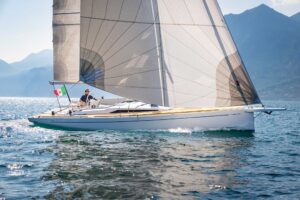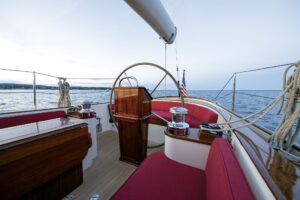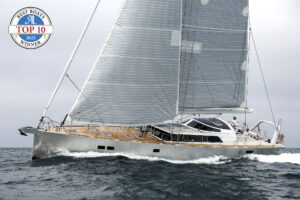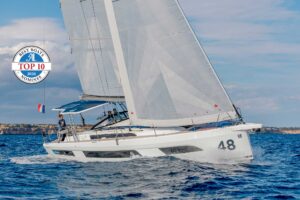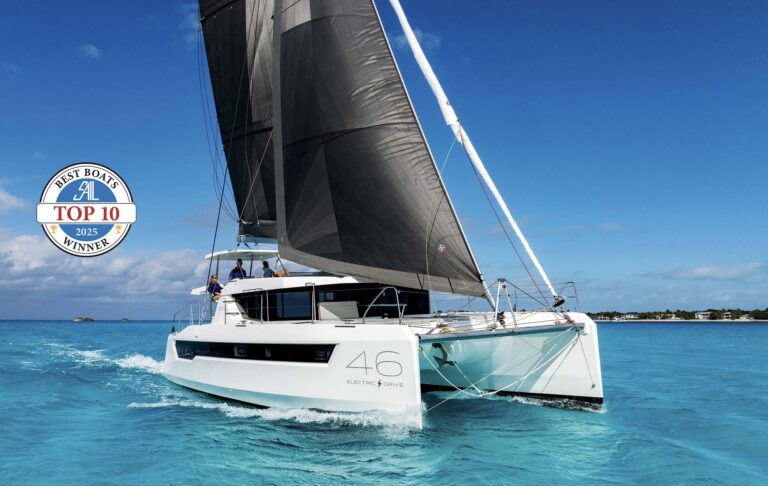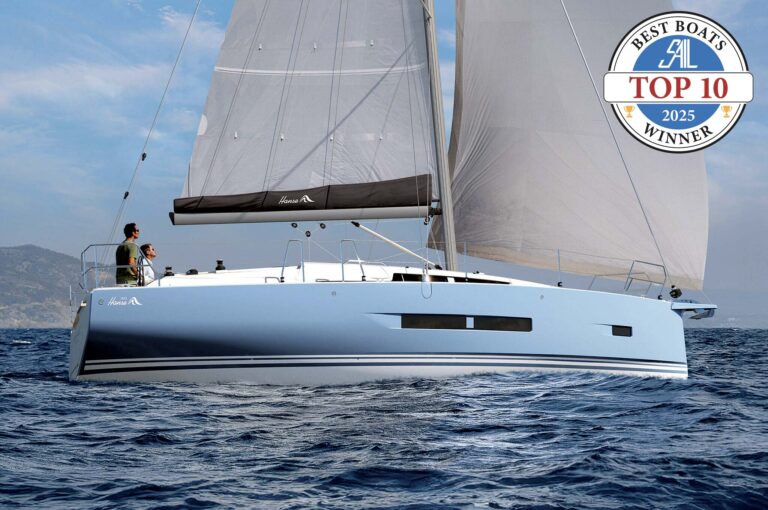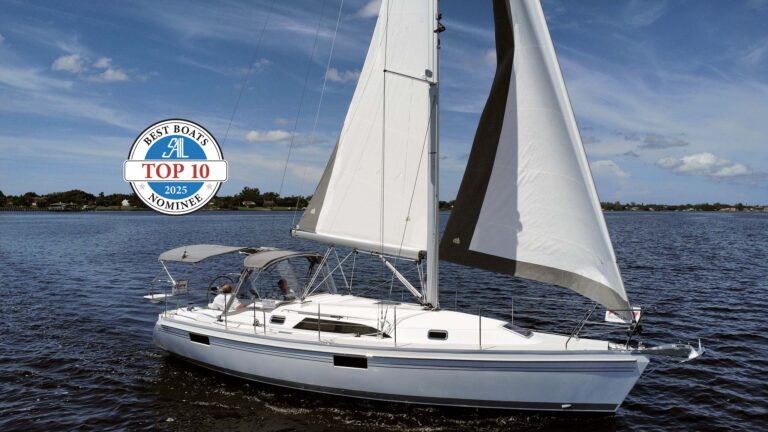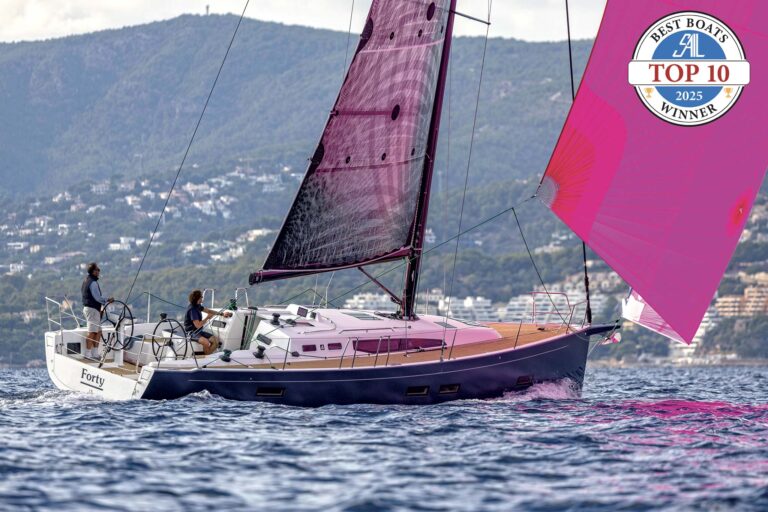
Ted Hood combines the best of power and sail
Three years ago Ted Hood and I had a long discussion about what would make a yacht move comfortably and confidently under both sail and power. It was the middle of February, and we were returning from a morning sail in the lumpy Gulf Stream off Miami aboard a new Hood–designed 48-footer with many of the qualities we were discussing.
The crisp northwesterly breeze following a midwinter frontal passage had been perfect for putting the yacht through its paces, and now we were headed back to Miami under power. Hood told me he’d been thinking for years about what a yacht needed to both sail and motor well. “While the word ‘motorsailer’ is catchy and easy to remember,” he said, “I’m not sure it’s the best word to describe what we’re trying to do, because so much more is involved than putting two disciplines together and hoping everything comes out all right.”
Hood, as most everyone in the world of sailing knows, has been designing yachts, both power and sail, cruising and racing, ever since he was old enough to draw a straight line on a piece of paper. Even though he reduced his design output when he was running his worldwide sailmaking enterprise, Hood Sails, he continued making notes on designs he liked and filed them away until he could get back to doing design work on a full-time basis.
Now that he’s back at the drawing board, Hood has pulled out his notes and has invested many hours in drafting, tank-testing, and building a yacht with all the elements his testing and years of practical experience tell him are needed for a vessel to perform well under both power and sail. There’s no question that this, his latest creation, is as far as you can get from a tubby motorsailer with a few steadying sails to keep it from rolling around while it’s being pushed through the water by an engine. This yacht embodies not only many of Hood’s baseline principles, but many new ones that take it far beyond the original concept of a motorsailer.
Hood ticks off his design criteria, which, he adds, have all received pretty equal weight in the final design. The yacht’s long waterline and relatively flat hull shape give it the high prismatic coefficient needed for producing good speed under sail and power. A tall masthead rig with in-mast furling, a double-headsail rig forward, and a collection of short-LP headsails make the sailplan easy to handle while providing the power to deliver forward motion in light air.
Hood has installed dual steering stations on deck and a single station below in the well-proportioned pilothouse; all locations have excellent visibility. There is also good visibility and a great feeling of spaciousness down in the main saloon, the galley, and all living spaces, thanks to large fixed windows installed at eye level along both sides of the hull.
A 300-horsepower John Deere diesel engine has the muscle to take the yacht wherever it needs to go and lives in a proper engine room worthy of the name. Finally, Hood has installed enough rugged equipment and provided enough stowage space for the yacht to be genuinely self-sufficient for extended periods of time.
The yacht’s relatively high freeboard gives it what I think is an appealing and
businesslike look. Yes, aesthetics always are subjective, but it’s also true that the higher a deck is above the waterline, the drier it will be. Hood has added to the yacht’s no-nonsense look by shaping the topsides amidships so they are almost vertical; waterline beam is about 15 feet, while beam on deck is just under 18 feet. And with a full-load displacement of around 54,000 pounds, the yacht is relatively heavy for its length. But Hood has always believed that heavy construction, shallow draft, and centered ballast produce a vessel with a more seakindly ride.
Finally—and not for the first time—Hood is using a Scheel keel he describes as “extreme” because it houses a centerboard. Invented in the mid-1970s by naval architect Henry Scheel, the Scheel keel is aerodynamically shaped with a bulb that can create the same amount of righting moment as a more conventional foil while requiring far less draft.
The keel on this yacht reduces maximum draft to about 61/2 feet. That should permit entry into almost any secluded anchorage, leaving the rest of the big-boat crowd looking for a place outside that’s calm enough to safely drop the hook.
Installing twin rudders—a concept used successfully on powerboats and sailing craft that include speedy wide-beamed inland scows and high-performance offshore monohull racers—is another interesting idea. Hood’s Expedition owners benefit because the shorter rudder lengths provide good control under power and sail and also work harmoniously with the shallow-draft keel.
CONSTRUCTION
Both the hull and deck are hand-laid fiberglass with a Core-Cell foam core; vinylester resin is used on the outer hull. All through-hull fittings and deck hardware run through solid fiberglass, and all design and construction plans conform to Bureau Veritas standards. All systems are installed in accordance with ABYC and Lloyd’s specifications.
Hood’s hull shape features a run aft that is far different from that found on many modern lightweight cruising boats that display flat chests forward and flat derrieres aft. The forward entry at the waterline is relatively fine, but the forefoot is relatively deep, and molded chines on both sides run aft from the bow toward wide but seakindly stern sections. A storage and swim platform at the transom is easy to access from the water or from a dinghy.
BELOWDECK
Because this is a semicustom design, it is always possible to personalize a space. It’s not really necessary, however, as this interior flows well throughout, even in the forward V-berth guest cabin and the cabin immediately aft of it, which has upper and lower berths. It’s perfect for housing guests, children, or a skipper and delivery crew. The master suite, all the way aft on this layout, is well endowed with hatches and windows that flood the space with natural light. Handsome solid-woodwork cherry brightens all the interior spaces. Another option has the master stateroom forward and the smaller crew cabin aft.
The galley is well equipped with everything one might want or need to serve up a four-course dinner or peanut butter sandwiches in a seaway. Hood notes that, in his considerable experience, “the fancier a kitchen gets, the less it tends to get used.”
Because the design of every yacht involves compromises between often-conflicting objectives, you have to know what your priorities are. In the Expedition 55 you have an opportunity to test your own beliefs against those of a designer who has invested years of study and practical experience to create a yacht that performs well under power and under sail. But whatever you do, don’t dare call it a motorsailer.
SPECIFICATIONS
EXPEDITION 55
Designer: Ted Hood Yachts, LLC
One Maritime Drive
Portsmouth, Rhode Island, 02871
Tel, 401-682-1712
www.tedhoodyachts.com
LOA54’10”
LWL49’5″
Beam17’11”
Draft (board up/down)(6’5″/12′)
Displacement54,200 lbs
Ballast18,000 lbs
Sail area (100% foretriangle)1,451 sq ft
Auxiliary300-hp John Deere turbodiesel
Fuel540 gal
Water300 gal
Sail area-displacement ratio16.21
Displacement-length ratio202.15

